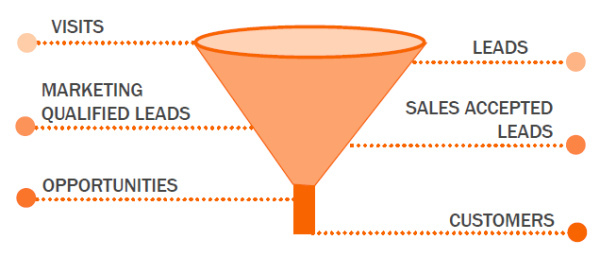You’re passionate about photography, writing, or digital design, and you believe your service provides value. However, you’re just not sure how to get the attention of your audience, where to find prospects, and how to turn those prospective customers into paying clients.
It may seem daunting, but the process can be simplified when you understand what your sales funnel looks like, and how your target audience moves through that funnel to transform from lead, to prospect, to customer.
Below, I’ll start by defining what a typical sales funnel looks like, then I’ll take you through sourcing leads – nurturing and engaging those contents into prospects – and ultimately closing the deal.
What Is a Sales Funnel?
In the simplest terms, a sales funnel is a visualization of the ideal process you intend your customers to experience as they go from a lead, to a prospective buyer, to a customer:
While the funnel can vary from business to business in terms of where you source prospects and how you engage with them, it’s typically broken down into three stages:
1. Awareness
The opening of the funnel is where you’re capturing the initial attention of your audience and beginning their education. However, you’re not pushing, promoting, or educating them on a specific solution – it’s too early (at the moment) to sell to them.
You’re providing information on topics, questions, and issues that matter to them most. Awareness is where the foundation of trust begins.
This is also the widest part of your funnel, which means it’s not about delivering precision content. You’re casting a wide net to get your audience’s attention.
2. Evaluation
If you’re standing in a store, deciding between a number of different products to purchase, you may want the advice of a sales rep – but you’re not yet ready to buy. A rep trying to close a sale before you’ve made a decision would frustrate you – you’ll likely want some help narrowing your choices, and you need to trust the rep enough to help lead you, rather than sell to you.
In the evaluation phase (or consideration phase), you’re tackling bigger, more specific issues that your audiences is looking for online. Your goal here is to serve content to help them solve specific challenges.
Your audience is acutely aware of their issue, and they’re also aware of your brand and what you can provide. Your engagement here solidifies trust as they make comparisons, weigh up the pros and cons, and look for information on how a specific solution will solve their problem.
3. Purchase
The purchase phase is the bottom of your sales funnel. Leads at this stage have interacted with you enough, and absorbed enough top and mid-funnel content, that they’re ready to make a choice.
That doesn’t guarantee a sale, but they’re likely to convert. Your engagement focuses on overcoming final objections and highlighting the value proposition of your solution, empowering them to make an educated decision.
Sourcing Leads
Your audience won’t just stumble into your sales funnel by accident. For freelancers, the opening of your sales funnel is the inbound and outbound marketing you’re doing to generate traffic, and the funnel only works if you’re feeding leads into it.
Here are some of the most common ways freelancers feed their sales funnel:
- Content marketing utilizing blogging, videos, podcasts, infographics, audio, and more.
- Promoting posts, and creating ads on Twitter, Facebook, Instagram, etc.
- Local networking events, such as BNI groups or industry trade shows.
- Cold contacts (including email, cold calls, and direct mail.)
Nurturing Leads into Customers
Finding leads to feed your sales funnel is the easy part. The real challenge is nurturing the relationship through value-driven engagement that makes someone see the benefit of doing business with you, and creating the trust to move them to the final phase.
Lead nurturing is often done through continued engagement on social channels, blog content, and via email campaigns directed at leads you’ve captured.
For example, you create an opt-in offer for a free e-book on local marketing. For anyone who converts, you continue to engage them through a series of emails loaded with advice that builds trust and engagement.
Eventually, you present an offer to your subscribers for a discount on a service as part of your autoresponder series. Your subscribers are more likely to convert because you’ve built a relationship and you’re offering a helpful solution.
Conclusion
The work doesn’t end when you close a sale. As a freelancer you constantly need to feed your funnel to generate new clients and revenue. Remember the following:
- Use multiple lead sources, and generate content to feed new prospects into the top of your funnel.
- Continually market value-oriented content to build new relationships (and maintain existing relationships) in the evaluation phase of your funnel.
- Provide actionable information and valuable engagement to move leads (new and old) into the purchase phase.
Never stop marketing your freelance business, and continue to nurture leads and current customers to ensure consistent growth and new business.
Do you have a strategy for nurturing leads through your own sales funnel? Share your tips in the comments section below!
Image credit: Eric Delcroix.


Leave a Reply